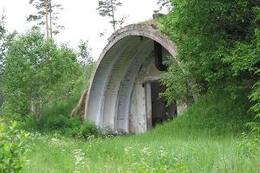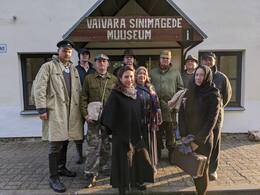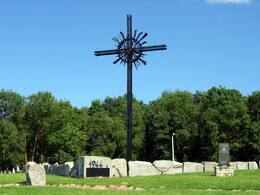The Soviet Army in the occupied territory of Estonia
Hara Harbor and Submarine base
Hara Harbour is situated in the village of the same name in Harju County.
There was a border guard outpost on the shoreline facing the island of Hara which was used during both the imperial era and the era of independence prior to World War II. The outpost was taken over by the Soviet Border Guard during the occupation of Estonia. A military harbour – the historic Hara submarine base or degaussing station – was constructed nearby. Degaussing was done using underwater technical facilities and enabled ship and submarine hulls to repel magnetic mines.
The whole port area used to be a restricted zone. Currently the port houses a visitor centre and is used as a marina. The history of the base can be explored on site, with the quay and ruins also accessible to visitors.
Kadila and Rohu Missile Bases
This missile base is situated around 10 km from the small borough of Väike-Maarja.
It formed part of the nuclear missile base established in Rakvere during the Soviet era. The base was operated from Rakvere during the 1960s and 1970s. It was closed in 1978, having been depreciated.
What remains today is mostly in ruins. Some of the missile, maintenance and storage hangars and landing fields are still intact.
Forest brothers bunker in Lebavere
In 2020, a forest brother bunker was reopened in Lebavere forest. The bunker was created in 1944–1954 on the model of one of the bunkers of the forest brother Martin Tamme, who hid in the forest, based on the memories of his brother Kaljo Tamme. Martin Tamm lived in such a bunker for the last six years in the forest. In 2001, Väike-Maarja Parish built a bunker for visitors to visit, which was now out of date. Under the leadership of the Väike-Maarja Museum Friends Society, the same bunker and memorial plaque were restored in the forest.
For information and to visit the forest brother's bunker, contact the Väike-Maarja Museum Friends Society with the tour guide. Visiting the bunker with a tour guide is with a fee.
Vaivara Sinimägede Museum and Battlefield Memorial
This museum is located in the renovated barn of Vaivara Manor in the small borough of Sinimäe.
Its exhibition showcases the World War II battle of the Narva River and the Blue Hills in 1944. It displays firearms, uniforms, soldiers' personal belongings, wartime photographs, propaganda posters from both sides and more. A big screen shows historical films and documentaries. Despite the topic of war being difficult for some, the exhibition is intended for all ages: while parents can concentrate on the history and the details, the children can interact with the items on display. Historical battlefronts (the 3rd defensive line of St Petersburg and the German East Wall defensive line known as the Tannenberg Line) can be found near the museum.
Sinimägede (Blue Hills) battlefield memorial
This memorial is situated on the western slope of Grenaderimägi Hill in the Blue Hills near the old Vaivara cemetery.
It symbolises the battle fought in the Blue Hills during World War II between Soviet and German forces.
The first monument in the Blue Hills area – a 6.5-metre wooden cross – was erected here in 1994. The current memorial was completed in 2000. The 12-metre steel cross, which towers over a hectare of land, was designed by artist and blacksmith H. Müller. In the middle of the cross is a composition depicting an explosion. In 2004, a monument in honour of the 20th Waffen Grenadier Division was added to the memorial. Two years later, monuments commemorating the Dutch and Walloon volunteers who fought alongside the Estonians were added.
Grenaderimägi Hill regularly changed hands from one battle to the next. The last point of defence, known as the ‘Hellhole’, was around 100 metres to the east of the memorial cross.








